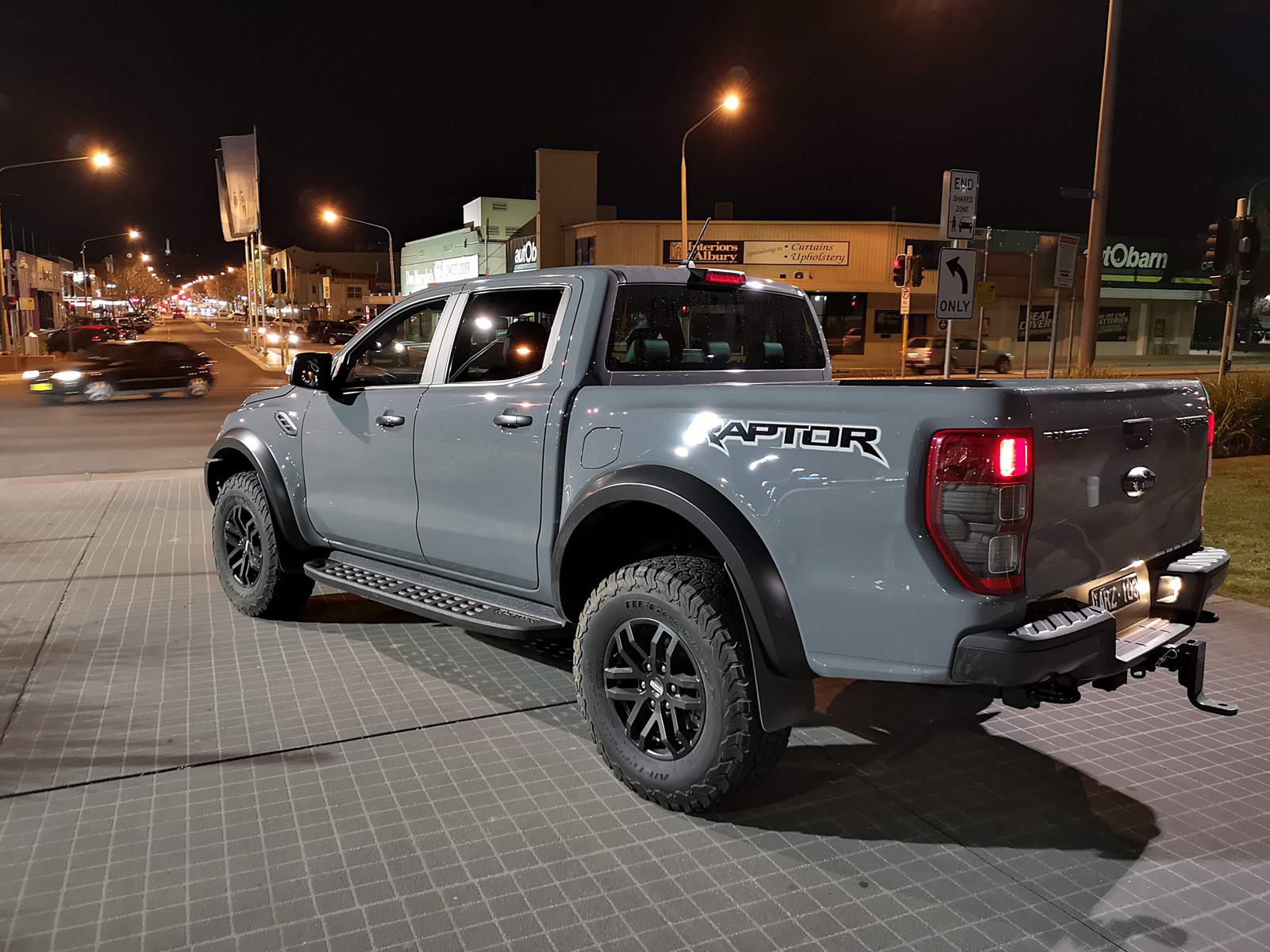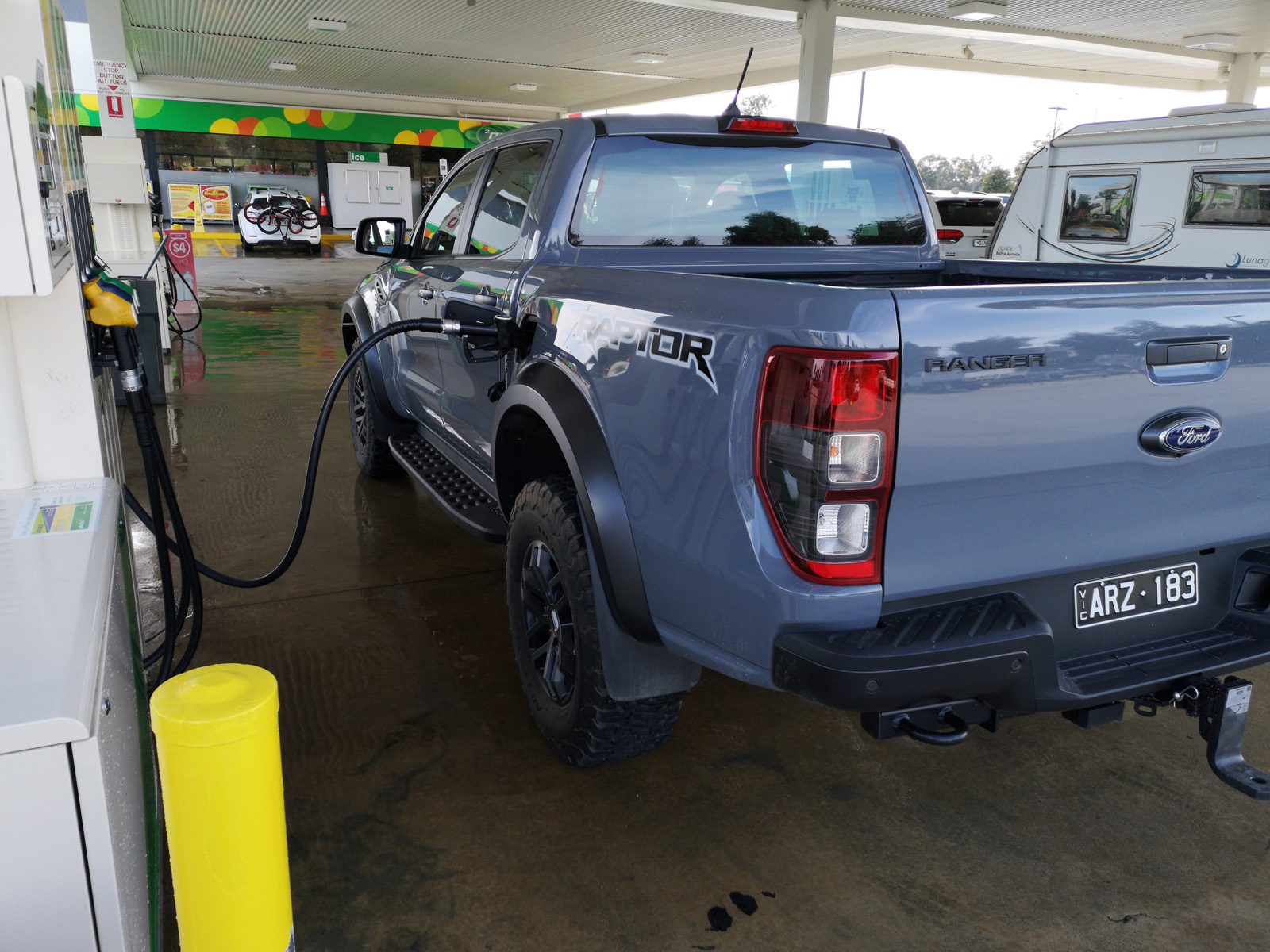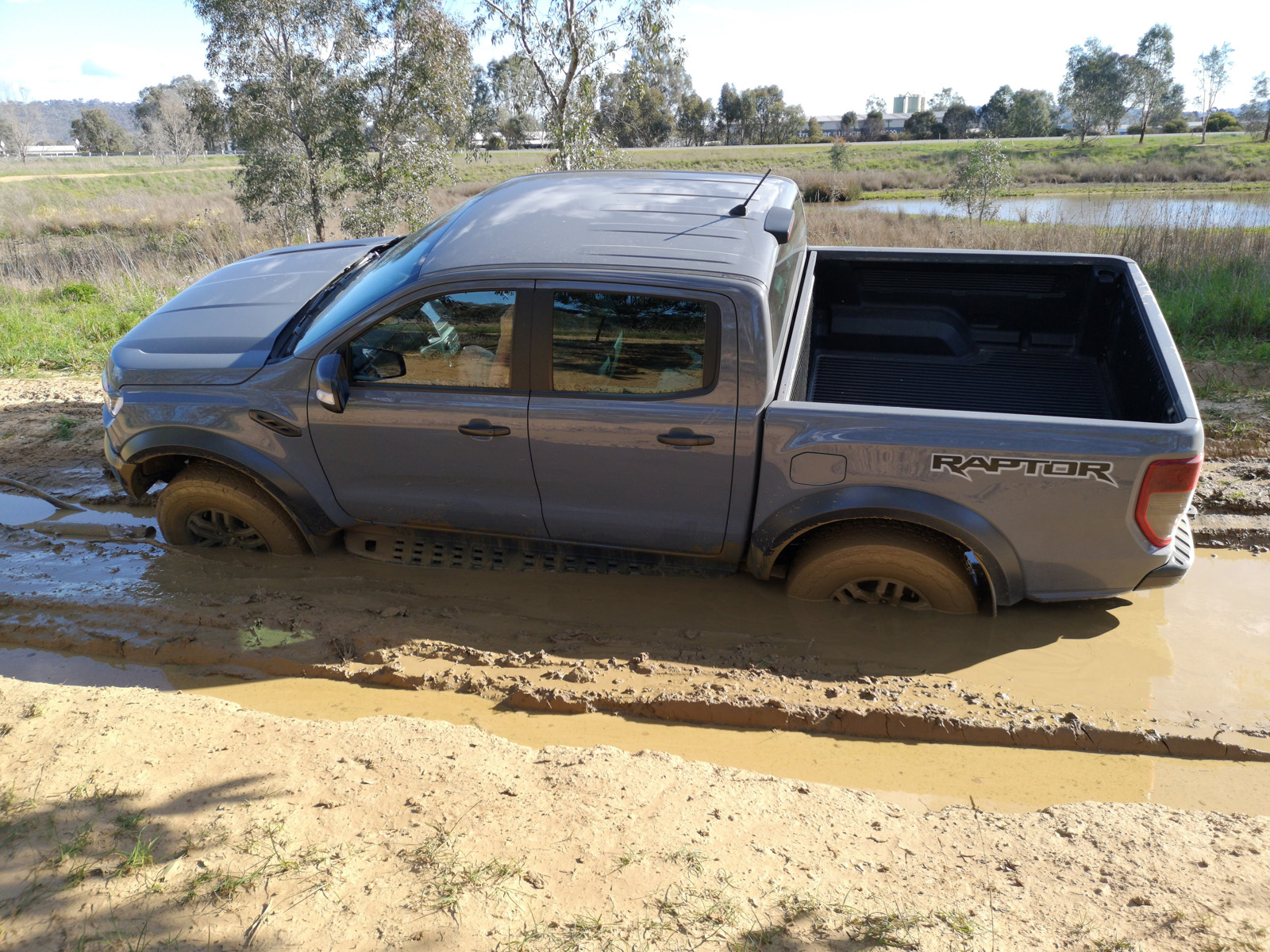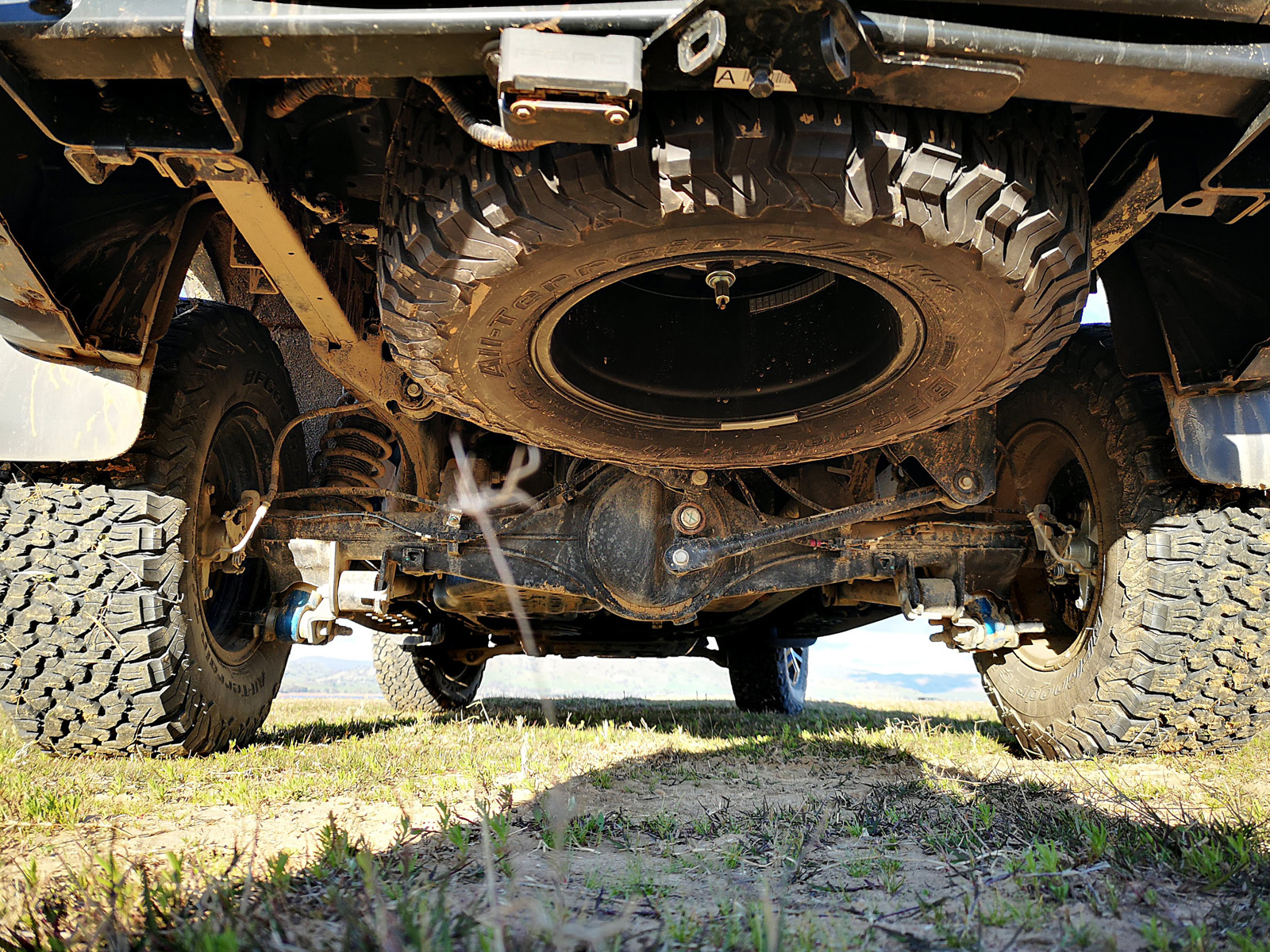Ford’s Ranger Raptor is now the flagship for the long running and very successful, Australian-designed Ranger. The Raptor is the brainchild of Ford Performance, their racing division, so you know they don’t do things by halves and on the Raptor, they turned the dial right up to 11 (on most things).
What’s on offer here is some serious upgrades to the suspension, namely Fox shocks that can take an absolute beating. There’s upgraded hardware on the front with a big metal crash plates and even industrial strength side rails also ‘built Ford tough’, from metal.
It seems Ford seen a thriving aftermarket in 4WD accessories and decided to make a factory offering to meet a growing need in the market. While you may be able to add mods to your Ranger for less money, it seems the draw card here is factory-backed reliability, backed by a warranty.

Ford Australia selected a relatively controversial powerplant for the Ranger Raptor. It’s just 2.0L in size which may instantly turn some people off this big truck, but from that 2.0L, 4 cylinder bi-turbo diesel engine, it’s good for 157kW and 500Nm of torque.
While this is 1.2L smaller in size, it’s important to remember this vehicle has Ford Performance badges on it, which means that power is deployed in a way that means it’s actually really capable.
The default drive mode is a little laggy when you plant your foot, but when you kick it into sport mode (2WD only), then you can easily spin the rear wheels. While I didn’t tow anything during the review, the Raptor certainly can, albeit a little down on towing capacity compared to the regular Ranger, as a result of the focus on suspension.


That suspension focus means the car has real presence on the road. During my week of driving, I spotted plenty of Wildtrack drivers looking up with jealousy, and in terms of driving positions, you have one of the highest rides on the road, easily looking over the top of most other 4WDs.
The Raptor looks imposing when standing still, mainly thanks to the substantial change to the ride height and ground clearance. This comes in the form of front suspension made up of Independent MacPherson struts, featuring FOX 2.5″ Internal Bypass shocks with Position Sensitive Damping.
This accounts for around 30% more suspension travel than the standard Ranger. That extra height means you can reach locations otherwise off-limits to anything less than the most serious off-roaders. It helps get you through higher water should you need to and it also means speed bumps are basically non-existent which is just plain fun.
On the rear, you’ll find Watts Link coil-spring rear suspension, featuring FOX 2.5″ Internal Bypass shocks with Position Sensitive Damping. This helps with the handling and on gravel, dirt etc, it’s fantastic. On the tarmac, don’t confuse it with a sports car, you can’t overcome physics, something sitting this high, won’t feel like its on rails around a round about. The steering was easy, much more direct in Sports mode, but the steering wheel was a little larger than it needed to be.


Interior 

Driver’s view 

Convenience lighting 

ISOfix baby seat 

Sync 3 

Center console 

Front seats 

Sunglasses 

View from the back seats
Drive modes
The Raptor has 3 drive settings and 6 drive modes. These work in unison to provide the best driving experience on whatever terrain you find yourself on.
There’s a knob on the center console that reads (2H, 4H, 4L). These high and low gears and 2 and 4 wheel drive modes are easy to switch between, simply turn the knob, however the 4L is restricted to 5km/hr. The great thing is there’s no need to pull over and stop to change between 2 and 4WD, just turn the knob and some smart gizmos underneath do all the work.
As you turn the corner from the bitchumen to the gravel road, you use the controls on the left of the wheel to switch the drive mode to ‘Grass/Gravel/Snow’. Instantly the truck feels calm and capable on this surface, even at speed. Taking corners was a breeze and for those who really want a challenge, there is a button to turn off traction control, just be careful.
The full list of drive modes are Normal, Sport, Grass/Gravel/Snow, May/Sand, Baja, Rock. Each of these are pretty self-explanatory and you will get told from the dash if you need to switch between 2WD and 4WD to enable any particular drive mode. It would be nice if this switch was done automatically for the driver, given the shift is essentially an electronically controlled one.
In reviewing the Raptor, I needed to expand how I reviewed vehicles. Taking it off-road was not something I’ve done a lot of, and certainly not for a long time, but in the Raptor, it feels like the world constantly throws challenges at you and the Raptor whispers suggestively in your ear, ‘Go on, do it’.
I took the Raptor off-road in a quiet space down the bush, where it handled the rough, dirt tracks in a breeze. After stumbling across a section with a descent and climb, it was time to try out that suspension for real. The first few times I took it easy, really easy, going about 5-10km/h. The raptor ate this challenge for breakfast, so I decided to circle around, do it again and get some speed into it. On the climb, it seems I got a little excited with the loud pedal and this happened..
While that’s definitely the first vehicle I’ve jumped, I really hope it’s not the last. The Raptor landed on all 4 wheels and those shocks soaked up the landing like a champion. Inside the cabin, there was not even a hint of a monster truck jolt on landing, it was super smooth and made me love the Raptor. Any factory-built vehicle that can do that is simply amazing. Remember this thing weighs 2.3+ tonnes and I just had all 4 wheels off the deck.


Economy
With an engine putting out these numbers (even being small), you can expect the Raptor to be pretty thirsty and drink through its 80L tank at a rate of between 11.4L and 13.0L. The official metrics list 8.2L/100km (combined) but I never got anywhere close to that. A number of 4WD owners said that’s still pretty good efficiency compared to what they get.



The Raptor combines the right equipment to not only be capable, but also look tough and capable as well.
The 17″ black alloy wheels are wrapped in massive 33″ BF Goodrich All-terrain tyres (285/70 R17). Inside those rims are some decent brakes. Up front there’s 332×32 vented discs, while the rear gets 332×24 vented discs.
Of course the Raptor has big recovery hooks on the front and rear, great for anchoring a winch to, should you somehow manage to get this thing stuck.
Continuing the off-road testing I also took the Raptor for a quick trip around a local off-road track. About a minute in, I found out exactly how inexperienced I am at driving off the black stuff. I managed to get the Raptor stuck in some deceivingly deep, muddy water (those wheel tracks can be deceiving).


My poor passenger was stuck, but I was able to climb out the driver’s side to dry land and assess the situation. The rear left wheel at sunk to leave the rear axle on that side, below water (mud) and the front axle wasn’t much better. The wheels were spinning, I was stuck.. or so I thought.
After realising that the front-right still had a firm grip on the dry stuff, I jumped back in the Raptor, turned hard right, gave it some beans and the Raptor drove right out of there. Again, bloody seriously impressed at the vehicle’s abilities. A quick trip to the car wash and the Raptor was ready for duty again.


Needs a clean 

Carwash time 

The entry to fun 

Check out that clearance


The Raptor features a very comfortable cabin, made better thanks to it’s technology, making your time inside entertaining and connected.
The driver’s instrument cluster is a 4.2″ multi-function display, as well as the primary center screen, a 8″ colour touch screen. When you connect a phone, you’ll take over the Sync 3 interface with Android Auto or Apple CarPlay. If you want to skip on the cable connection, there’s the standard Bluetooth connectivity.
As you drive the Raptor, you’ll enjoy modern tech like automatic headlights, dual-climate control parking sensors and a reverse parking camera. Something I really missed was Adaptive Cruise Control. So transformative is that technology that I really wouldn’t buy a car without it, it’s the cruise control of our generation and is fundamentally safer, making sure you don’t drive up the back of the vehicle ahead if you take your eyes off the road for a second, it has your back.
If you connect a trailer to the Rapor, you’ll also get the assistance of the trailer sway control. If you do decide to tow, the Raptor has a towing capacity of 2,500kg, while the cargo-lined rear-tray is good for a payload of 758kg.


The Raptor Ranger gets a lot of things right, but here’s my list of things that should be addressed in future iterations of the Raptor.
• Lack of storage in the cabin
• No Adaptive Cruise Control
• Engine Start/Stop system can’t be defaulted to off.
• Cruise control has to be enabled each time.
• Driver footrest is tiny.



While you can get into the base Ranger from around $31K, you’ll need to dive a little deeper into your piggy bank for the Raptor, with the sticker price hovering around $81K.
To put things into perspective, the previous top dog was the 4×4 Wildtrack dual-cab variant, also with a 3.2L Diesel engine. This costs around $65K after adding automatic transmission and some better paint and wheels, it lands around $70K.
This means the price distance to the Raptor isn’t an insignificant one and those upgrades do certainly come at a price.


The Raptor is a big truck that’ll make you feel like a very capable human being, ready to drive over an obstacle you come up against. When you drive the Raptor, everything looks like a challenge. Steep inclines, dirt roads and it’s seriously tempting to drive over things, just because you can.
Inside the cabin is a great office to have, with really comfy seats, but I do worry about the practicality of the carpet, I expect rubber floor mats will be one of your first purchases as this thing is no crossover 4WD wannabe, it will be driven off-road and will get dirty.
Our review Raptor was ‘Conquer Grey’, which is a great colour if you like the military, industrial look, however I love the ‘Blue Lightning’, if you see it in person, it’ll be hard to choose the gray. The Raptor is also available in Frozen White, Shadow Black and Race Red.
Ford Performance have done a great job with the power, suspension and design of this vehicle. It’s impressive in what it can do, but if you’re considering one, just understand what you’re buying. It’s bigger and slightly less capable for day-to-day stuff, but if you’re someone who loves crazy weekends off-road, then you will love the Raptor.
I don’t think there’s anyone I’ve spoken to who doesn’t comment that the engine should be bigger and I tend to agree, it hurts not in performance, but in perception and while I can tell you the Raptor is incredibly capable, people will see that number 2 and run for alternatives. The Raptor also isn’t the only game in town, with many other Ute/Truck manufacturers, now setting up, or already offering a factory spec super-truck.
As I handed back the Raptor I knew i’d miss it, and I do, it was a seriously cool car to experience for a week, it was a pain to park, given it’s size, but I’m used to a medium-sized sedan. It’s the capability to go anywhere, do anything that I really miss. I know there are roads I can’t drive on with my car (lowered), driveways I can’t go up, but in the Raptor, you feel powerful, capable and in charge.
The Raptor should be cheaper, at $70K, it’d be a clear decision for the top Ranger customers to opt-up to, but at the current price, I fear many will still go down the aftermarket route.

Brilliant review Jason. This is our next vehicle and agree about the adaptive cruise control. Trailer sway is a great feature also. Cheers for the in depth review.
Thanks Thommo, glad you like it. As for ACC, hope Ford add it for future versions, definitely a big improvement to the driving experience.
I own one an have done 5000km in a month. I’m averaging 9.5 combined around Melbourne with the auto-engine on all the time and on the highway it’s coming out at 7.7 with two Adelaide trips under its belt. It has already pulled a modded land cruiser off the beach and stomped Trig track up Baw Baw way. To date I’m yet to be concerned by the engine, in fact the 10 speed gearbox keeps it in the sweet spot. Thanks for the review!